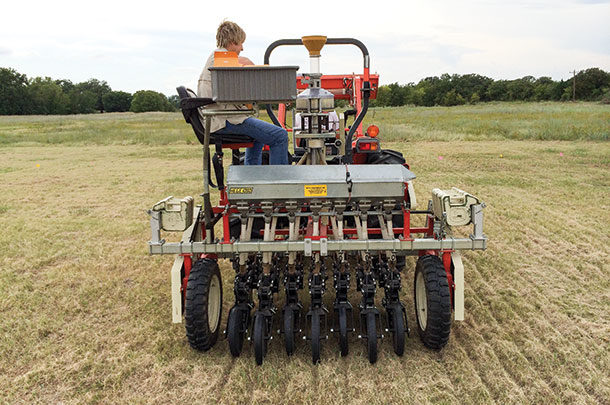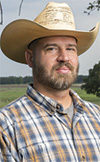There is also some interest in using cover crops during the summer growing season of the perennial grass to increase or complement the existing forage production. However, planting cover crops or multi-species grazing crops into established grass is very different from trying to use cover crops in cropland between cash crops.
It is not an entirely new system since winter pastures of small grains, ryegrass and legumes have been overseeded into bermudagrass pastures in the Southern Great Plains for decades.
Unfortunately, there is little information on how some of the newer, more novel or exotic cover crop species can be adapted to this environment, or if they can work in this system.
In the fall of 2014, the Noble Foundation began working on demonstration plots of various cover crops overseeded into warm-season perennial grass (WSPG). The plots were in four locations in north Texas to evaluate their adaptability to this environment. Plot locations were near Gainesville (Pace), St. Jo (Parker), Rosston (Leo) and Forestburg (Thomsen).
Entries in fall 2014 and spring 2015 included barley, oat, black oat, triticale, rye, wheat, ryegrass, corn, sorghum, sorghum-sudan, sudan, pearl millet, foxtail millet, browntop millet, proso millet, chickpea, spring pea, winter pea, chickling vetch, common vetch, hairy vetch, lentil, sainfoin, alfalfa, cowpea, soybean, mung bean, guar, sunn hemp, radish, collard, turnip, mustard, rape, flax, buckwheat, phacelia, plantain, safflower, chicory, sunflower, sugar beet and clovers (crimson, berseem, Persian, rose, red, white, sweet, subterranean, alsike, arrowleaf and alyce).
Additional entries of Japanese millet, teff, balansa clover, faba bean, okra, medics (burr, rigid and button), and a comprehensive mixture were added in fall 2015 and spring 2016.
Each entry was planted separately with a no-till plot drill. Planting depth on the drill was not adjusted or varied for different species. However, due to the unevenness of no-tilling into sod, a variety of depths were obtained over the plot area. Each species was planted within the range of acceptable full-planting rate for north Texas.
Plots of all entries, both warm-season and cool-season species, were planted in the fall and spring. Customary practice for overseeding bermudagrass pastures with winter annuals in the fall typically includes using a burn-down herbicide. We purposefully chose to try this without using herbicides or other pesticides. Instead, we used mowing, grazing or weather (temperature and day length) to prepare the WSPG for planting.
Our hope is this will be an additional challenge to the cover crops’ establishment we can use to help select the more vigorous entries.
Plots were observed and given a numeric rating based on subjective visual appraisal on a regular basis during active growth. The rating scale was 0 through 4:
0 = None present
1 = Poor
2 = Fair
3 = Good
4 = Excellent
These observations were based on stand uniformity and vigor and relative plant growth compared to expected growth for an individual species.
No ratings were taken in the fall and winter of 2014/2015 due to the lack of growth. The first ratings took place in April 2015 before spring planting. Additional ratings, after growth from the spring planting, were taken in June 2015 at the two sandier locations (Parker and Leo). The other two locations did not grow due to excessive rain, leading to very poor growth.
In spite of difficult weather, the fall and spring of 2014 and 2015 were not a total loss. We did observe the sorghum species were able to establish and provide growth in the fall prior to frost, even with the competition of the WSPG. They were also some of the few species with any growth when planted in spring 2015.
While most entries did not perform well in fall 2014, many made significant growth in the late winter and early spring of 2015. Perhaps much of the seed lay dormant in the ground until winter, when enough moisture was finally available for germination.
Entries that made significant late winter, early spring growth included the small grains, ryegrass, vetches, pea, crimson clover, flax and chicory. We were surprised none of the brassicas performed well.
Based on our observations from this learning year, we decided to plant later in the fall and earlier in the spring to avoid as much competition from the WSPG and focus on taking advantage of favorable growing conditions during the time the WSPG was dormant.
In fall 2015, there were a few warm-season entries that made significant growth even though they were terminated by frost a few weeks after planting. They were cowpea, sunflower and grazing corn. Others that made good fall growth were the small grains, ryegrass, peas, vetches, lentils, alfalfa, several of the clovers, faba bean, flax, chicory and the mix plot.
The biggest surprise of these was the faba bean. It is a true cool-season bean that is tolerant of light freezes and may overwinter in north Texas and areas further south. During the winter, some of these plots declined and others continued to get better as additional ratings were taken. Again, we were surprised none of the brassicas performed well. It could be said that they were hit or miss, with more miss.
The sorghum species made significant growth when planted in spring 2016. Others that did well when planted in spring 2016 were peas, cowpeas, soybeans, sunn hemp, flax, buckwheat, chicory, plantain, okra and the mixed plot. However, all of these were soon choked out by the WSPG.
In the coming year, we plan to continue evaluating species that have performed well in the plots so far. We will concentrate on cool-season entries that grow during the dormant season since it is difficult for the cover crops to establish and compete with the WSPG while it is growing.
We will plant near the first frost, but shift the spring planting to a late winter planting. The species in this system will include triticale, oat, rye, wheat, barley, ryegrass, pea, vetch, lentil, faba bean, radish, mustard, flax, chicory, plantain, button medic and the clovers (crimson, Persian, rose, red, sweet and white). In the future, we hope to evaluate various mixtures of these. ![]()
PHOTO: Over 50 cover crop varieties were planted separately with a no-till drill at a variety of depths to evaluate stand establishment and vigor when overseeded into warm-season perennial grass pastures. Photo courtesy of Noble Foundation.

-
Jim Johnson
- Soils and Crops Consultant
- Noble Foundation
- Email Jim Johnson












